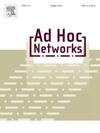Intelligent clustering and routing protocol for wireless sensor networks using quantum inspired Harris Hawk optimizer and deep reinforcement learning
IF 4.4
3区 计算机科学
Q1 COMPUTER SCIENCE, INFORMATION SYSTEMS
引用次数: 0
Abstract
Dynamic changes in wireless sensor networks (WSNs) present significant challenges to clustering and routing protocols, particularly impacting energy efficiency and network lifetime. Existing protocols often fail to address the trade-off between energy conservation and optimal cluster based routing, especially in highly dynamic environments. This paper proposes an Intelligent Clustering and Routing protocol for WSNs, called ICR-HHODRL, which innovatively integrates the Quantum-inspired Harris Hawk Optimizer (QHHO) for clustering and Deep Reinforcement Learning (DRL) for routing, aiming to improve energy efficiency, improve network throughput, and maximize network lifetime. The protocol minimizes message overhead by dynamically selecting optimal cluster head (CH) and forming clusters using QHHO with a new fitness function that considers node’s residual energy, average distance to neighbor nodes, and distance to the base station (BS), ensuring a balanced distribution of energy and CHs. Furthermore, ICR-HHODRL leverages a Dueling Double Deep Q-network (D3QN) with priority experience replay (D3QN-PER) for adaptive learning of optimal routing policies, addressing dynamic network conditions and enhancing load balancing. Experiment results show that the proposed ICR-HHODRL protocol outperforms several state-of-the-art clustering and routing protocols. Specifically, network lifetime is improved by 14.85%, 18.46%, 15.17%, 17.69%, and 14.77, network throughput is increased by 5.7%, 7.29%, 5.69%, 10.02%, and 7.21%, and network energy consumption is reduced by 16.96%, 20.03%, 15.51%, 8.61%, and 18.8%, compared to WOAD3QN-RP, MRP-ICHI, QoSCRSI, HHO-UCRA, and WOAC-HHOR, respectively. These findings highlight the protocol’s potential to significantly advance the state of the art in dynamic WSNs and offer promising solutions for low-power, resource-constrained networks.
使用量子启发的哈里斯鹰优化器和深度强化学习的无线传感器网络的智能聚类和路由协议
无线传感器网络(wsn)的动态变化对集群和路由协议提出了重大挑战,特别是影响能源效率和网络寿命。现有的协议往往不能解决能源节约和最优基于集群的路由之间的权衡,特别是在高度动态的环境中。本文提出了一种用于wsn的智能聚类和路由协议,称为ICR-HHODRL,该协议创新地集成了量子启发的哈里斯鹰优化器(QHHO)用于聚类和深度强化学习(DRL)用于路由,旨在提高能源效率,提高网络吞吐量,最大化网络寿命。该协议通过动态选择最优簇头(CH)和使用QHHO形成簇,并使用新的适应度函数考虑节点的剩余能量、到邻居节点的平均距离和到基站的距离(BS),确保能量和簇头的平衡分布,从而最大限度地减少消息开销。此外,ICR-HHODRL利用具有优先级体验重放(D3QN- per)的Dueling Double Deep Q-network (D3QN)来自适应学习最佳路由策略,解决动态网络条件并增强负载平衡。实验结果表明,所提出的ICR-HHODRL协议优于几种最先进的聚类和路由协议。其中,与WOAD3QN-RP、MRP-ICHI、QoSCRSI、HHO-UCRA和WOAC-HHOR相比,网络寿命分别提高了14.85%、18.46%、15.17%、17.69%和14.77%,网络吞吐量分别提高了5.7%、7.29%、5.69%、10.02%和7.21%,网络能耗分别降低了16.96%、20.03%、15.51%、8.61%和18.8%。这些发现突出了该协议在显著推进动态wsn技术发展方面的潜力,并为低功耗、资源受限的网络提供了有希望的解决方案。
本文章由计算机程序翻译,如有差异,请以英文原文为准。
求助全文
约1分钟内获得全文
求助全文
来源期刊

Ad Hoc Networks
工程技术-电信学
CiteScore
10.20
自引率
4.20%
发文量
131
审稿时长
4.8 months
期刊介绍:
The Ad Hoc Networks is an international and archival journal providing a publication vehicle for complete coverage of all topics of interest to those involved in ad hoc and sensor networking areas. The Ad Hoc Networks considers original, high quality and unpublished contributions addressing all aspects of ad hoc and sensor networks. Specific areas of interest include, but are not limited to:
Mobile and Wireless Ad Hoc Networks
Sensor Networks
Wireless Local and Personal Area Networks
Home Networks
Ad Hoc Networks of Autonomous Intelligent Systems
Novel Architectures for Ad Hoc and Sensor Networks
Self-organizing Network Architectures and Protocols
Transport Layer Protocols
Routing protocols (unicast, multicast, geocast, etc.)
Media Access Control Techniques
Error Control Schemes
Power-Aware, Low-Power and Energy-Efficient Designs
Synchronization and Scheduling Issues
Mobility Management
Mobility-Tolerant Communication Protocols
Location Tracking and Location-based Services
Resource and Information Management
Security and Fault-Tolerance Issues
Hardware and Software Platforms, Systems, and Testbeds
Experimental and Prototype Results
Quality-of-Service Issues
Cross-Layer Interactions
Scalability Issues
Performance Analysis and Simulation of Protocols.
 求助内容:
求助内容: 应助结果提醒方式:
应助结果提醒方式:


